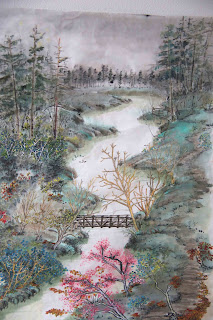Not knowing exactly how the bottom layer will come out after it has been superimposed, I decided to err on the cautious side and painted in most of the scenery, except for the obvious foreground. I also did this bottom layer with a more exaggerated tone. My theory was that this way the bottom layer would reveal itself better.
Then I decided to add a little interest to the work by painting in something dear, a Deer (bad pun).
Now it is time to do the top layer. I put my translucent Xuan on top of the bottom painting, and begin adding in foreground information.
It didn't take me long to discover a new problem. What I was viewing through the top layer is not what it would look after the 2 pieces are glued together. Gluing the two would have eliminated the air gap between them and illustrate the bottom layer much better. In the mean time, I could only guess.
So I stopped and wet down the top Xuan, just to get a more educated view of the bottom.
I hoped to integrate the top layer better with the bottom layer. I was hoping for a gradual transition from foreground to background.
Wanting to make sure that my deer is not so hidden, I re-painted it on the top layer for insurance.
This was how it looked when the 2 layers were mounted together. While still wet, thus the color was more vibrant, and the paper seemed more transparent.
Then I found out what it is like when the 2 layers were misaligned by just a millimeter. The eyes on the deer have migrated to the top of the head, instead of being lined up with the bottom edge of the ears!
Frantic reworking on the top layer solved that problem.
The painting lost some of its lustre after it was dried.
An application of gel medium brings back some of that color depth.
I was not too unhappy with the end result. I wish I could have done a much better job on these trees. Those are awful awful brushstrokes. I forgot about "writing" them in and I am not proud of them.
I also realized that no matter how saturated the background colors were, they just don't show through enough to make a difference. So for background information, it is better to be either succinct dark lines or large patches of color without intricate details. I also discovered the color on the top Xuan really obscures whatever is on the bottom layer. In order for the bottom layer to show through, I'll just have to have faith and do not embellish the top layer over the same spots.
















